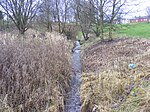Hopwood, Greater Manchester
Areas of the Metropolitan Borough of RochdaleGreater Manchester geography stubsHeywood, Greater Manchester
Hopwood is a suburb of Heywood, a town within the Metropolitan Borough of Rochdale, in Greater Manchester, England. It is north of the M62 motorway. During the Middle Ages, Hopwood formed a township within the Middleton ecclesiastical parish of the Salfordshire hundred of Lancashire.John Rhodes was one of the victims of the Peterloo Massacre of 1819. He died several weeks after the event and his body was dissected by order of magistrates wishing to prove his death was not a result of Peterloo.Hopwood has a primary school and a fire station for the Greater Manchester Fire and Rescue Service. It also has a dentist, petrol station/shop and a cafe.
Excerpt from the Wikipedia article Hopwood, Greater Manchester (License: CC BY-SA 3.0, Authors).Hopwood, Greater Manchester
Lane End,
Geographical coordinates (GPS) Address Nearby Places Show on map
Geographical coordinates (GPS)
| Latitude | Longitude |
|---|---|
| N 53.582128 ° | E -2.203179 ° |
Address
Lane End
Lane End
OL10 2JE , Lane End
England, United Kingdom
Open on Google Maps




